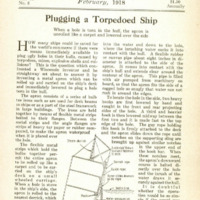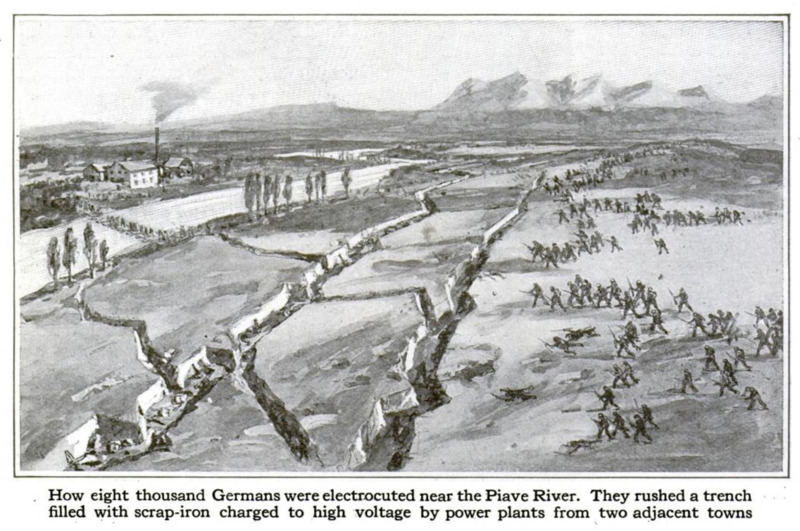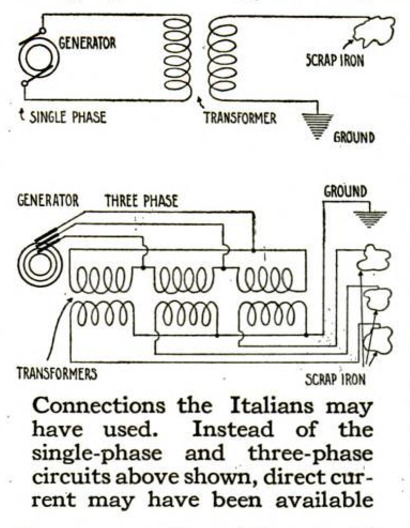Hell-trench of the Piave
Item
-
Title (Dublin Core)
-
Hell-trench of the Piave
-
Article Title and/or Image Caption (Dublin Core)
-
The Hell-Trench of the Piave. How an attacking German force was electrocuted as it rushed a second line of trenches
-
Caption 1: How eight thousand Germans were electrocuted near the Piave River. They rushed a trench
filled with scrap-iron charged to high voltage by power plants from two adjacent towns
-
Caption 2: Connections the Italians may have used. Instead of the single-phase and three-phase circuits above shown, direct current may have been available
-
extracted text (Extract Text)
-
WHEN the Italians stopped, a few
weeks ago, with their backs to
the Piave River, in northern
Italy, with the intent of delaying the
Austro-German advance
as much as possible, an in-
cident occurred which il-
lustrates the scientific re-
sourcefulness of the Ital-
ans and also shows how
much of a factor the unex-
pected can become, even
in this warfare of to-day.
It was certain that no
long stand could be made
on that side of the river;
the Teuton preponderance
in men and guns was too
great. Any expedient
which might gain hours,
however, was worth con-
sidering.
An Italian engineer by the name of
Mertilli was responsible for the plan.
Before the final German thrust was de-
livered, Mertilli caused the second-line
trench to be evacuated over a front of
eight miles, except by workmen.
In this second trench
he placed some discarded
machine guns, plates of
corrugated. dugout armor,
and even, some veteran
field pieces, which seldom
made an appearance in
the trenches. The whole
floor of the trench was
lined irregularly with
pieces of metal of different
kinds, so that no matter
where a man might step
he was likely to touch one
of the pieces. Then serv-
ice electric cables were
stretched to the trench,
across the Piave, from two
of the small towns just on the other side.
These carried the heaviest charge of
. electricity the plants were eapable of
turning out. The cables were connected
up by concealed wires with all the bits
of metal, the machine guns, the field
pieces and the corrugated armor. Safety
zones were left for the escape of the de-
fenders of the first trench, but all other
parts were connected with the electric
cables.
The next
morning the
German mass
. attack came,
driving the first
trench defend-
ers back re-
morselessly.
The huge body
of men swept
over the first
trench, and on
to the second.
Something
radically wrong
appeared there.
Men jumped in~
to the trench,
and it appeared
to be evacuated, yet the invaders did
not re-appear. The charging Germans
behind could not know what was wrong.
They came on and on, seizing the machine
guns, the old field pieces and whatever.
they could lay hands on. It is needless
to say that none of
‘these lived to tell the »
tale of their captured
trophies, for each was
electrocuted where he
first entered the trench.
All along the eight
miles, the condition was
the same. Of course
the German command
soon found out what
was wrong, but not
until nearly eight thou-
sand of the very best
of Germany's troops
were dead—and all
without a single Italian
casualty! And besides,
the attack was halted
for a day giving the
Italians time to reorgan-
ize their defenses, on the
other side of the Piave.
-
Contributor (Dublin Core)
-
E. T. Bronsdon (writer)
-
Mertilli (inventor)
-
Language (Dublin Core)
-
eng
-
Date Issued (Dublin Core)
-
1918-02
-
pages (Bibliographic Ontology)
-
220-221
-
Rights (Dublin Core)
-
Public Domain (Google digitized)
-
Archived by (Dublin Core)
-
Filippo Valle
-
Alberto Bordignon (Supervisor)
 Popular Science Monthly, v. 92, n. 2, 1918
Popular Science Monthly, v. 92, n. 2, 1918





